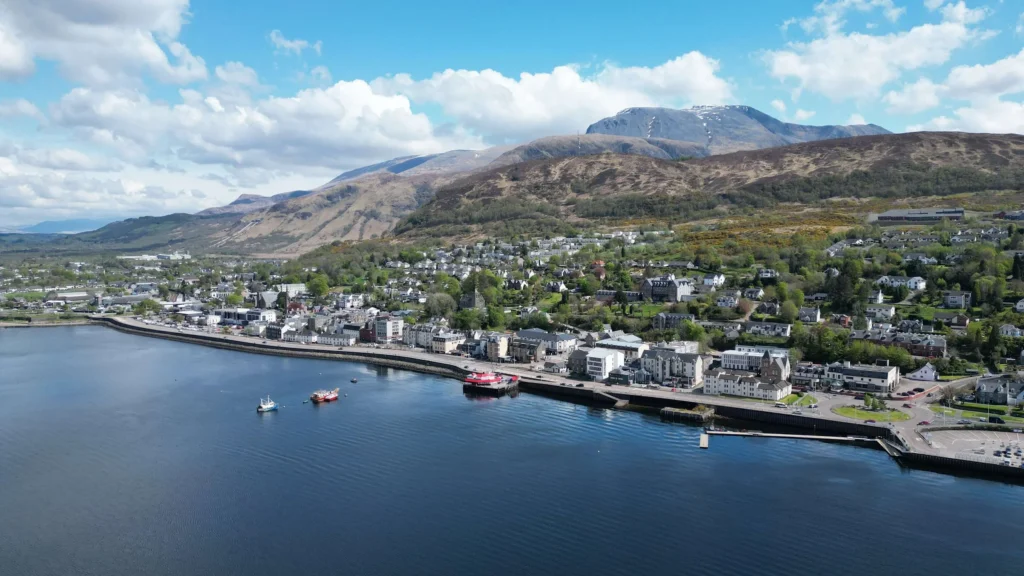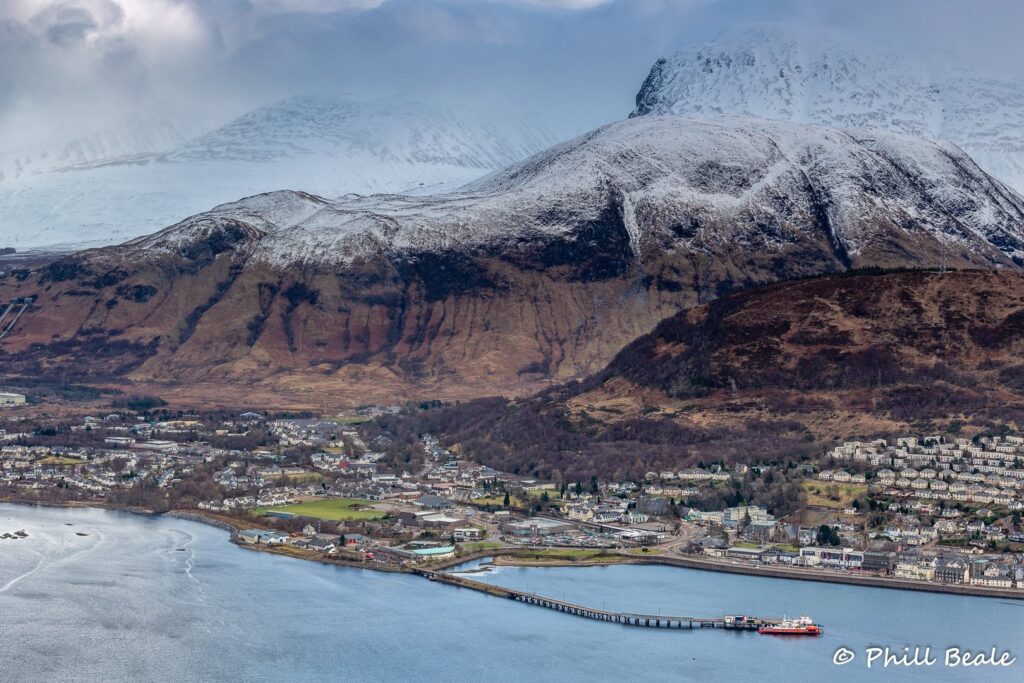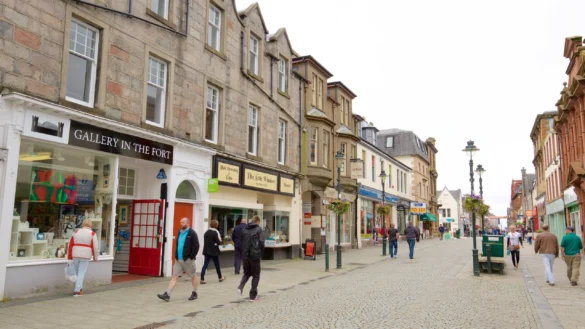Fort William, often referred to as the “Outdoor Capital of the UK,” is a town nestled in the western Scottish Highlands, lying on the shores of Loch Linnhe and beneath the looming shadow of Ben Nevis, the highest mountain in the British Isles. With its dramatic landscapes, deep history, and strong Highland identity, Fort William has long been a focal point for travelers, settlers, soldiers, and adventurers. Today, it stands as both a living town with a vibrant local community and a thriving hub for visitors who wish to explore the majesty of Scotland’s rugged north.

Geographic Setting
Fort William occupies a strategic position in the Great Glen, a geological fault line that runs diagonally across the Highlands from Inverness in the northeast to Fort William in the southwest. The town looks out over Loch Linnhe, a long sea loch that connects inland waterways with the Atlantic Ocean, and it is framed by some of the most spectacular mountains in Britain, including Ben Nevis, Aonach Mòr, and the Mamores. This geography is more than just picturesque; historically it gave the site both defensive importance and access to trade routes.
The town’s climate is typical of the western Highlands: wet, cool, and variable. Rainfall is frequent, contributing to the lush greenery, rivers, and waterfalls in the region. The ever-changing skies are part of the charm for many visitors, though the weather has also shaped the resilient nature of the people who live here.

Early History and the Fort
Before it became Fort William, the area was known by its Gaelic name An Gearasdan, meaning “the garrison.” The name reflects the military role of the site during the 17th century, when the English and later British government sought to establish stronger control over the often rebellious Highlands.
The original fort was constructed in 1654 under the orders of Oliver Cromwell, during the period of the Commonwealth, to suppress resistance from Highland clans. After the Restoration, the fort was expanded and renamed after William of Orange following his accession to the throne in 1689. Hence, “Fort William” was born.
The fort itself was strategically located at the head of Loch Linnhe, designed to help enforce royal authority and control movement through the Great Glen. Although much of the original fortification no longer exists — it was largely dismantled in the 19th century — its legacy gave the town its modern name and laid the foundation for the settlement’s growth.
The Jacobite Connection
Fort William played a significant role in the turbulent years of the Jacobite risings, when supporters of the exiled Stuart dynasty sought to reclaim the British throne. The fort was garrisoned by government troops and served as one of the key strongholds in the Highlands.
During the 1715 rising, Fort William withstood attempts at attack, and in the 1745 rising — the most famous, led by Bonnie Prince Charlie — it again remained under government control. While nearby strongholds like Fort Augustus fell, Fort William’s defenses and strategic coastal position enabled it to resist siege attempts. Its continued government occupation was a blow to the Jacobite cause, demonstrating the fort’s importance in the political and military landscape of the time.
Industrial and Economic Development
After the decline of military conflict in the Highlands, Fort William gradually developed into a town serving industry and commerce. Its coastal position and proximity to resources made it suitable for fishing, forestry, and later, aluminum production. In the 20th century, an aluminum smelter was established, bringing jobs and economic activity, though also tying the town to cycles of industrial growth and decline.
The Caledonian Canal, completed in the early 19th century, further linked Fort William to trade and transport networks. Running from Fort William in the southwest to Inverness in the northeast, the canal was an engineering feat by Thomas Telford and remains a major landmark. While it did not fully achieve its intended economic purpose as a commercial shipping route (superseded by railways and larger seagoing vessels), it became a lifeline for communities and a draw for tourism.
Modern Identity and Culture
Today, Fort William is a thriving small town of around 10,000–11,000 residents. Gaelic heritage remains important, and while English is the primary language, the town’s identity is closely linked to Highland traditions of music, storytelling, and community life. Visitors often encounter traditional ceilidhs (social gatherings with music and dancing), pipe bands, and celebrations of Highland culture.
The town also functions as a service center for the wider Lochaber region, providing education, healthcare, and commerce. Its high street features shops, cafés, and pubs catering both to locals and the steady flow of tourists.
Tourism and Outdoor Activities
Fort William’s reputation as the “Outdoor Capital of the UK” is well-earned. It is one of the most popular bases for hikers, climbers, cyclists, and adventure seekers.
- Ben Nevis: Towering at 1,345 meters (4,413 feet), Ben Nevis is a magnet for climbers and walkers. The Mountain Track (often called the “Tourist Route”) attracts thousands each year, while the mountain’s north face offers world-class rock and ice climbing challenges.
- The West Highland Way: Fort William marks the northern terminus of this long-distance walking route, which stretches 96 miles from Milngavie near Glasgow. Many walkers finish their trek in Fort William, often celebrating with a well-earned meal or drink in town.
- The Great Glen Way: Running from Fort William to Inverness, this route follows the Caledonian Canal and Loch Ness, appealing to walkers and cyclists who wish to traverse Scotland’s geological heart.
- Nevis Range: The ski resort at Aonach Mòr offers winter sports, but also summer attractions such as mountain biking, gondola rides, and hillwalking.
- Loch Linnhe and Nearby Glens: Boat trips, kayaking, and wildlife watching are popular, with opportunities to see seals, otters, and even golden eagles.
Landmarks and Attractions
Several attractions highlight the town’s cultural and natural heritage:
- West Highland Museum: Located in the town center, it houses exhibits on the Jacobite era, Highland life, and local history.
- Old Inverlochy Castle: Just north of town, this 13th-century ruin tells the story of medieval Scotland and was the site of two major battles.
- Glenfinnan Monument and Viaduct: A short drive away, Glenfinnan is famous both for its Jacobite connections and its appearance in the Harry Potter films.
- Steall Waterfall: Accessible via a scenic walk through Glen Nevis, this is one of the highest waterfalls in Scotland.
Fort William in Popular Culture
Beyond history and tourism, Fort William has made appearances in film and literature. Its landscapes have been used in productions ranging from Braveheart to Harry Potter, with Glen Nevis and the surrounding hills serving as backdrops. The town and its people often feature in travel writing and memoirs, as many authors are captivated by the stark beauty and cultural richness of the area.
Challenges and Future Outlook
Like many Highland communities, Fort William faces challenges of sustainability, housing, and balancing tourism with local needs. The influx of seasonal visitors brings prosperity but also strains infrastructure. Young people sometimes leave for larger cities due to limited opportunities, though initiatives in education, renewable energy, and digital technology aim to strengthen the local economy.
Environmental concerns are also pressing. The Highlands’ ecosystems are fragile, and balancing outdoor recreation with conservation is a constant dialogue. Groups in Fort William work to ensure that the natural landscapes remain pristine while still accessible to those who wish to enjoy them.
Conclusion
Fort William stands as a microcosm of the Scottish Highlands: shaped by a history of conflict and resilience, enriched by natural beauty, and defined by a community that embraces both tradition and modernity. Whether one visits to climb Ben Nevis, walk the West Highland Way, explore Jacobite history, or simply breathe in the Highland air, Fort William leaves a lasting impression.
It is not just a town at the end of a glen, but a living, evolving gateway to one of the most extraordinary regions in Europe — a place where mountains meet lochs, and history meets adventure.

